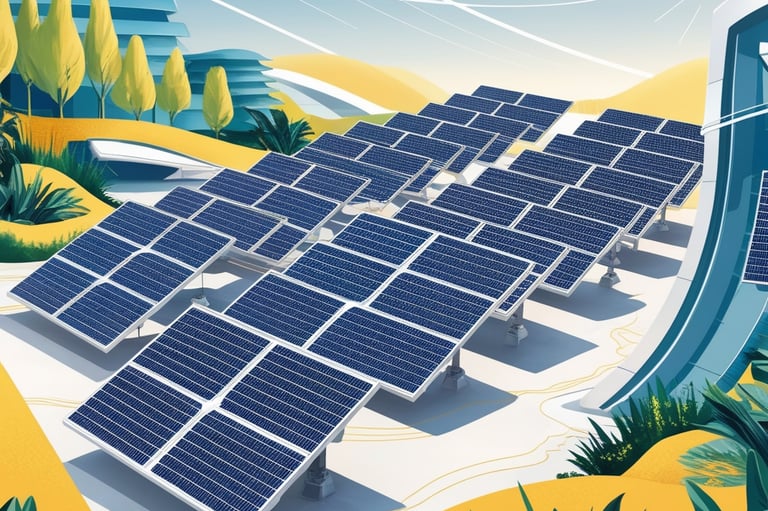21 Solar Power Facts and Stats
Key facts about solar energy and solar power and its usage
FACTS AND DATA
GW Authors
6/11/20253 min read
Solar power is one of most used renewable energy sources and is there is a reason for that. In this article, we will look into the most significant solar power facts.
Potential Power of Solar Energy
Sunlight is the greatest potential energy on earth. But only a small fraction of the earth’s surface is captured and used to make electricity.
There is enough sunlight, every hour and half that reaches the earth’s surface to meet the world’s energy needs for an entire year
Solar power has more potential than other renewable energy sources for electricity production in the U.S
Renewable energy technologies in the U.S only harnessed 0.2% of the total renewable energy potential since 2020.
Solar in the U.S set to grow their renewable energy capacity by 67% in 2023
The world’s current solar energy capacity is 850.2 GW (gigawatts), which is the maximum of energy that the global solar installations can generate all at once
China’s role in solar energy usage
China reportedly installed 24.4 GW of solar power systems, which is sufficient enough to power over four million homes in the U.S, and this was their capacity in the first half of 2017
A report from China’s National Agency showed that the country’s solar electric power surged by 55.2% in 2023, and more than 216 GW of solar power is built by China in 2023.
The country has set an emission peak by 2030 and wants to reach neutrality by 2060 and committed to constructing 1200 GW of renewable capacity by 2030. China has already shown a 20.7% rise in wind power generation capacity which makes them an important stakeholder in renewable energy
Solar industry wants to generate more electricity by 2030
The solar industry wants to generate 30% of electricity using solar power, which requires stronger political shift.
The company using the most solar energy
The leading U.S business and brands are making great investments in solar energy, and the one that uses the most is Meta. It has the most solar capacity installed, and other ones that are worth mentioning is Amazon, Apple, Walmart and Microsoft. Meta uses 3588 MW, while Amazon uses 1113 MW, and Apple at 987 MW.
Solar power is more available than you think
Around 173 000 terawatts of solar energy continuously hit the Earth which is more than 10000 times more than the world’s total energy use.
The time it takes for light to travel from the sun to the Earth, and is the equivalent distance of 90 million miles.
Overall energy from solar power
Renewable energy sources were responsible for 38% of the total electricity generation, where solar accounted for 11.5% of the total renewables which is overall a percentage of 4.37%.
11.5% of global renewable energy comes from solar power, and the largest renewable energy source is at the moment from hydroelectric 57.7% and followed by wind 21.4%.
Countries that rely most on renewable energy
First place goes to Luxembourg which has a reliance of 17.9%, followed by Yemen (15.4%) and Chile at 12.9%. The next on the list is Jordan at 11.7% and Australia with 10.9%, and the world average is only at 3.7%. Countries such as Chile, Yemen, and Jordan did not solar power 10 years ago, but has changed things and taken advantage of their many sun hours during the year. Chile has 4432 of sun hours, meanwhile Yemen has 4438 sun hours in one year, and Jordan has the lowest of the three with 3602 hours of sunlight annually.
Employment in the solar industry
In the solar industry, there are over 3975096 working in the solar PV industry globally, and an additional 820 000 work in the solar heating and cooling sector worldwide.
Types of solar energy jobs
The most common jobs in the solar energy sector are installation and construction, with a percentage of 67%. This is followed by manufacturing with 14%, followed by sales and distribution with 11%, operations and maintenance of 4% and other of 4%. The installation jobs have decreased by 4.2% to 154610 which happened during the pandemic, but is expected to grow the next common years.
Solar energy price
The price of photovoltaic (PV) modules is major factor in the cost of solar power, and is measured in cost per kWh (kilowatt hour).
The cost of solar is decreasing rapidly, and another metric that is important in solar is LCOE (Levelized Cost of Energy/Electricity) which is metric that measures different sources of electricity generation, which takes considers, operating, installation and maintenance cost over a lifespan.
In 2010 the costs were 0.381$ per kWh and has since dropped to 0.057$ pr kWH in 2020, and it may drop even further in the near future.


Sources
Forbes
Ecowatch
Contacts
greenlyworld@hotmail.com
